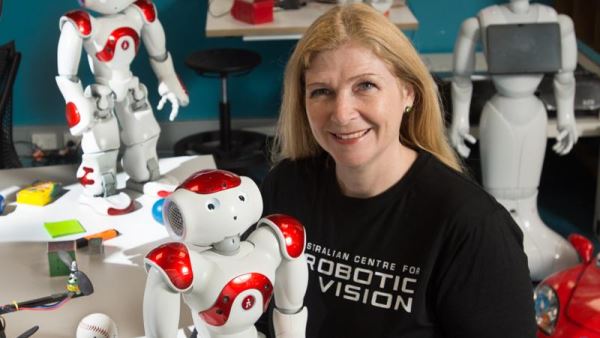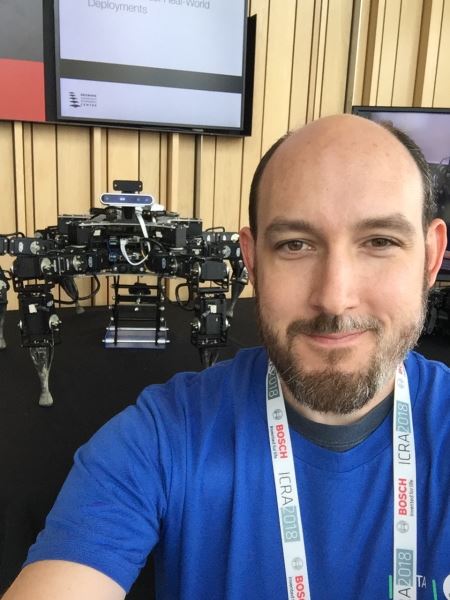Industry 4.0 – the fourth industrial revolution – has brought with it the rise of the robots.
Robots and artificial intelligence are changing the world as we know it – and countries at the forefront of this technology will be the big winners.
Demand for robots is growing at a frenetic pace. Worldwide spending on robotics is expected to reach US$188 billion in 2020.
Though Australia is not renowned for making high tech machines, its research and development in the field of robotics is now commanding worldwide attention.
And Australia is in a prime position to ultimately take this ground-breaking technology to global markets.
Research hubs like the Australian Centre for Robotic Vision in Brisbane are leading the way. Formed in 2014, it’s the world’s first research centre specialising in robotic vision.
Chief operating officer Dr Sue Keay and her dynamic team of researchers are on a mission to give robots the ability to see and understand. Their research will help to improve quality of life of millions of people across the globe.
International collaboration
The centre has assembled an interdisciplinary research team from four leading Australian research universities – Queensland University of Technology, the University of Adelaide (UoA), Australian National University (ANU), and Monash University as well as CSIRO’s Data61.
The team also collaborates with leading universities and research organisations internationally including INRIA Rennes Bretagne, Georgia Institute of Technology, Imperial College London, the Swiss Federal Institute of Technology Zurich, and the University of Oxford.
The innovative research conducted by the Centre for Robotic Vision, QUT and Data61 was a key factor in persuading organisers to stage the world’s biggest robotics conference in Australia this year.
Over 3000 of the world’s leading robotics experts recently gathered in Brisbane for the prestigious International Conference on Robotics and Automation (ICRA 2018).
Growing global reputation
It’s the first time ICRA has been held in the Southern Hemisphere, reflecting Australia’s rapidly growing global reputation in robotics.
A total of 1052 papers were presented and 7520 pages of (electronic) proceedings were generated at the conference.
ICRA 2018 Chair and Australia’s Chief Defence Scientist Dr Alex Zelinsky said the event provided a powerful opportunity for Australia to showcase its trail-blazing robotics technology to the world.
“There are so many Australians and Australian universities, institutes and companies doing great things in robotics that are changing the face of agriculture, mining and resources, health and age care, defence and even the arts,” he said.
National robotics R&D strategy
As the conference drew to a close, Australia’s robotics industry was given a huge boost with the announcement that a Sixth Wave Alliance (SWA) would be established to develop a national robotics R&D strategy.
The Alliance brings together Australian industry, research and government collaborators to promote and facilitate the adoption and creation of robotics and automation technology for the benefit of Australian industry.
Announcing the new Alliance, CSIRO’s Data61 said robotics and autonomous system technologies have the potential to solve issues of safety and productivity across industries.
Organisations involved in SWA include Data61, AlphaBeta, Department of Industry, Innovation and Science, METSIgnited, NERA (National Energy Resources Australia), QUT, University of Queensland and Woodside.
Other entities interested in advancing Australia’s robotics opportunities are being encouraged to join.
Putting Australia on the map as a global leader
“The country’s robotics opportunity lies in using robots and sensors to capture information about complex environments and to automate tasks that would otherwise be completed by humans in high risk situations and at a greater cost,” said Adrian Turner, CEO at CSIRO’s Data61.
“As every sector becomes data-driven, areas like Australia's healthcare, agriculture, manufacturing and mining industries are primed for enhancement via robotics and autonomous systems.
“SWA will allow us to put Australia on the map as the global leader in robotics.”
The Alliance will focus its efforts on a range of industries primed for transformation through autonomous technologies. These include defence, agriculture, oil and gas, mining, transport, and smart cities. Other areas the alliance will address include STEM education, research and training.
Mr Turner said the national robotics R&D strategy will create opportunities for the robotics industry to work with the Australian government and private sector to drive scale and make Australia more globally competitive.
Robotics eco-system is very fragmented
Senior engineer Fred Pauling, the leader of CSIRO’s Robotics Systems Group, says there is great robotics research currently underway in Australia, but the robotics eco-system is very fragmented.
“The new alliance is about connecting the eco-system and making it more visible to Australian industry and the world,” he said.
For the first time, industry, researchers and government will join forces to advance Australian robotics technology.
“If we can harness that correctly, it will provide more opportunities for businesses to grow and develop.”
In the past, many Australian organisations that have developed new technology have been forced to take it overseas because of a “lack of visibility in Australia.
“By connecting the eco-system and making it more visible – and promoting the growth of that eco-system – we will have companies that will support and service the new technology.”
Creating new industries
Mr Pauling says robotics is helping to remove people from unsafe and hazardous working environments such as underground mining.
“It will touch every industry and in the long term it will create new industries.
“This new technology can be used to benefit Australian industry and eventually it can be exported to the world.”
Mr Pauling says SWA will give Australia an outstanding opportunity to lead the way as a robotics thought leader.
“Depending on the outcomes it could be a model for other countries to follow,” he said.
SWA’s main goals will be to:
-
Change the negative perception of robots as “job killers” and highlight the benefits
-
Encourage the adoption of robotics technology in Australian industry to improve productivity, profitability and safety
-
Encourage research and collaboration and support organisations to commercialise new technology.
Regular meetings
The Alliance plans to meet on a regular basis and is expected to develop an agenda aimed at meeting its goals.
How will SWA measure its success?
“That’s always difficult,” Mr Pauling admits.
“Maybe in five years’ time if more companies are adopting this technology to improve their production, safety and profitability and the number of jobs in industry has increased – that could be a measure of success.
“And when more politicians are prepared to talk about robotics and its benefits that could be a sign we have been able to influence the debate.”
For more information or to join the Sixth Wave Alliance, visit: www.data61.csiro.au/SixthWave


